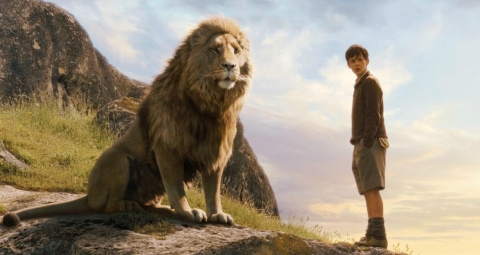September 20 | ![]() 0 COMMENTS
0 COMMENTS ![]() print
print

The works of CS Lewis direct both young and old to God
Emily Black on why children’s stories are not just for kids
As a child, I read CS Lewis’ The Chronicles of Narnia with wonder, and as an adult I often return to the magical world he created. Through Lewis’ writing, the reader experiences a remarkably vivid image of the Pevensie children entering Narnia: a wardrobe door is opened, and we step into his imagination.
It is a joy to inhabit, especially if you are lucky enough to have nostalgic childhood memories of encountering the stories for the first time.
CS Lewis famously said that a children’s story that can only be enjoyed by children is ‘not a good children’s story in the slightest.’ The central Christian themes of his work have enduring salience and the world he created is as immersive and as enchanting when read as an adult.
Lewis wrote The Lion, The Witch and The Wardrobe for his niece Lucy and named the heroine after her, but in the inscription at the beginning he wrote: “I had not realised that girls grow quicker than books.”
In his mind, Lucy had become too old for magical stories when the book was finally published, but he suggested that she might one day be ‘old enough to start reading fairy tales again.’
He told his niece to one day take down the book ‘from some upper shelf, dust it, and tell me what you think of it.’
Christianity in Lewis’ work
Lewis lead a life devoted to Christ, and all of his works have an element of Christian apology—throughout his well-loved children’s fantasy, his lesser known science fiction and his academic and theological writings, he uses analogy and symbolism to exact an insightful exploration of questions and truths at the heart of Christianity.
In The Chronicles of Narnia, Lewis weaves key elements of salvation history through the various storylines, from creation and The Fall, to Christ’s death and Resurrection.
But it is more than just a simplistic biblical analogy dressed up in a fantasy world.
The American Catholic podcast Abiding Together describes itself as ‘providing a place of connection, rest and encouragement for women who are on the journey of living out their passion and purpose in Jesus Christ.’ Headed up by Sr Miriam James, the podcast includes regular book studies and earlier this year it examined The Lion, The Witch and The Wardrobe in four episodes.
The podcasters’ discussion is illuminating; they look at Lucy’s innocence and Edmund’s treachery, pulling out revealing passages and scenes to examine Lewis’ commentary on the human condition.
They approach Lewis’ exploration of humanity and God from a Christian perspective, but they are not the first readers to notice the allegorical element of these stories.
If we see Narnia as a kind of mirror of our own world, then the majestic lion Aslan—son of the ‘Emperor-over-the-sea’—who sacrifices himself, rises from the dead, defeats evil and heralds the return of spring after an endless winter, is an obvious analogue of Christ.
He is awesome, powerful and often terrible. The Narnians repeatedly tell the children that ‘he is not a tame lion.’ Lewis seems to give Narnia’s Christ a paw in each Testament, reconciling wrath with gentleness, vengefulness with mercy in order to render a true, holistic facsimile of our own Christ, our own God as we encounter him throughout the Bible.
Aslan’s likeness to Christ is also revealed by the way other characters perceive him. For instance, Lucy, who is the youngest of the four children, believes wholeheartedly in Aslan as soon as she is told about him. Because of this, she is the only one able to see him at first, then, as the others come to believe in him, they begin to see him too.
This echoes the idea that Faith allows us to see God clearly, and the general mystery and awe surrounding Aslan is similar to that surrounding Jesus as he begins his ministry in the New Testament.
Christ analogy
Aslan’s similarities with Christ build throughout the series, but in The Voyage of the Dawntreader, Lewis suggests he is not merely an allegorical figure.
Aslan tells Lucy and Edmund that they will never be able to return to Narnia but urges them not grieve because he exists in their world too.
“But there I have another name. You must learn to know me by that name. This was the very reason why you were brought to Narnia, that by knowing me here for a little, you may know me better there,” Aslan says.
Through all his fantasy work, Lewis works to balance magic with realism. His narrative style regularly invites us—with a hint of tongue-in-cheek playfulness—to accept that the ‘real world’ in the story is the real world.
Aslan is the Christ of Narnia, but he directs the children towards the Christ of their own world, our Christ.
The chronicles are rich with Christian spirituality and symbolism, and the struggles of good and evil that play out point to profound truths. Ultimately, Lewis meant these stories to lead the reader—young or old—to a better understanding of Jesus.
It may seem childish to take down a copy of a children’s story from ‘some upper shelf’ and dust it off, but Lewis himself urges us to do so—and for those willing to venture in, there are treasures in store, and perhaps a unique, magical encounter with Christ.










